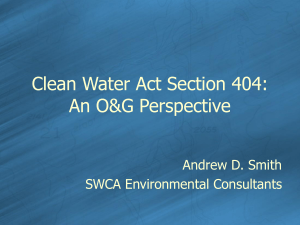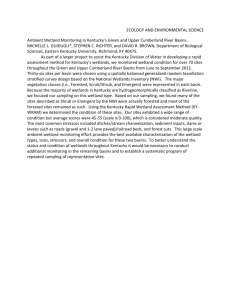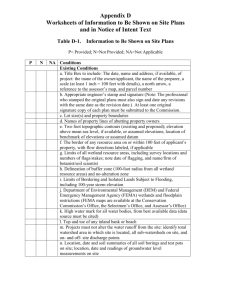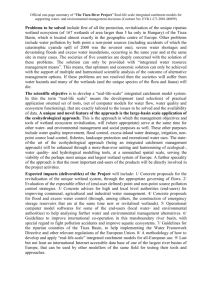Is Metroparks constructing a wetland with Lucas County tax dollars
advertisement
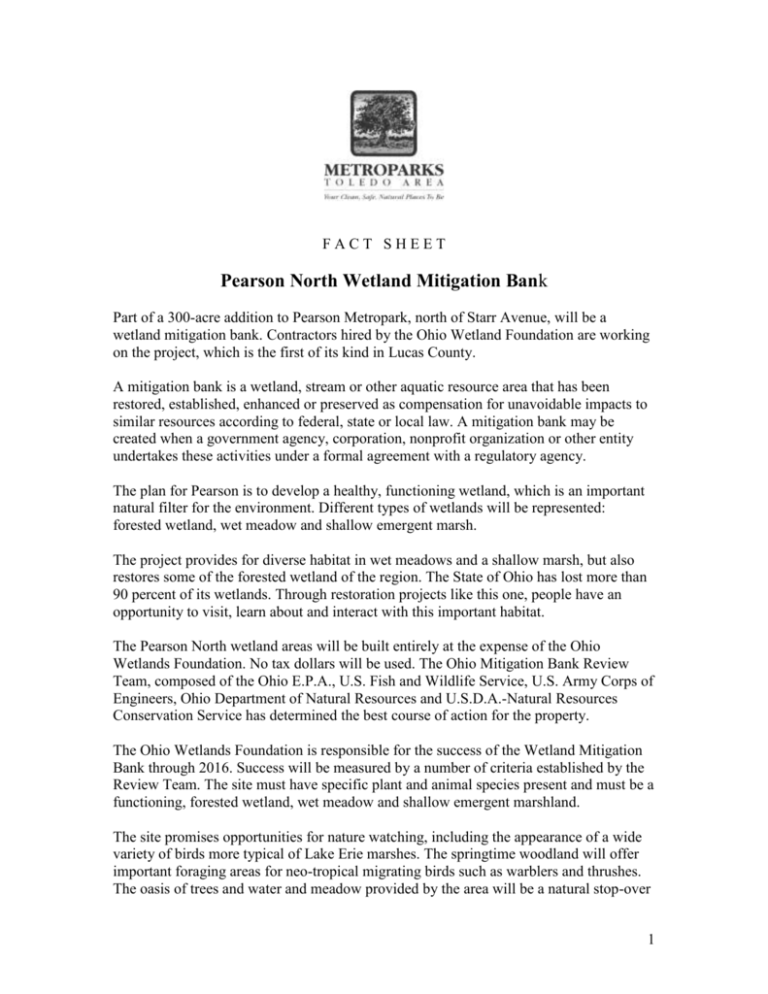
FACT SHEET Pearson North Wetland Mitigation Bank Part of a 300-acre addition to Pearson Metropark, north of Starr Avenue, will be a wetland mitigation bank. Contractors hired by the Ohio Wetland Foundation are working on the project, which is the first of its kind in Lucas County. A mitigation bank is a wetland, stream or other aquatic resource area that has been restored, established, enhanced or preserved as compensation for unavoidable impacts to similar resources according to federal, state or local law. A mitigation bank may be created when a government agency, corporation, nonprofit organization or other entity undertakes these activities under a formal agreement with a regulatory agency. The plan for Pearson is to develop a healthy, functioning wetland, which is an important natural filter for the environment. Different types of wetlands will be represented: forested wetland, wet meadow and shallow emergent marsh. The project provides for diverse habitat in wet meadows and a shallow marsh, but also restores some of the forested wetland of the region. The State of Ohio has lost more than 90 percent of its wetlands. Through restoration projects like this one, people have an opportunity to visit, learn about and interact with this important habitat. The Pearson North wetland areas will be built entirely at the expense of the Ohio Wetlands Foundation. No tax dollars will be used. The Ohio Mitigation Bank Review Team, composed of the Ohio E.P.A., U.S. Fish and Wildlife Service, U.S. Army Corps of Engineers, Ohio Department of Natural Resources and U.S.D.A.-Natural Resources Conservation Service has determined the best course of action for the property. The Ohio Wetlands Foundation is responsible for the success of the Wetland Mitigation Bank through 2016. Success will be measured by a number of criteria established by the Review Team. The site must have specific plant and animal species present and must be a functioning, forested wetland, wet meadow and shallow emergent marshland. The site promises opportunities for nature watching, including the appearance of a wide variety of birds more typical of Lake Erie marshes. The springtime woodland will offer important foraging areas for neo-tropical migrating birds such as warblers and thrushes. The oasis of trees and water and meadow provided by the area will be a natural stop-over 1 for birds, and meadows with wildflowers will provide important nectaring sources for butterflies and insects. A Black Swamp interpretive area with an 1860s cabin will help to establish a “sense of place” for visitors to explain why pioneers chose northwest Ohio as their place to settle. Why are large earth moving machines working the ground? Work began in the fall of 2006 to prepare the site southwest of the railroad tracks for tree planting, shallow marsh and wet meadow planting. The second phase of the project, east of the railroad tracks, will be completed by Summer 2008. Work has included excavation of several feet for shallow emergent marsh. This site was chosen as the best location to mitigate six acres of wetland lost in Lucas County, and to provide some diversity of habitat. Large construction pans and bulldozers first removed topsoil from the area which will be replaced for replanting native vegetation. Excavated clay material was be used as base material for future public areas, parking lots and a roadway. Why are there so many deep ruts and tracks through the fields? The ruts were made on purpose as part of the wetland construction. This method has proven to successfully provide elevation differences to duplicate the topography of a wetland forest floor. Over time, with freeze, thaw and rainfall, the ruts will level-out. Over time, with an increase in water level and vegetation, soil compaction caused by the ruts will be eliminated. The land was naturally flat, why change it? The land historically contained vernal, or springtime, pools, including those caused by uprooted trees when it was a swamp forest. The area was also in the coastal transition zone to Maumee Bay and Lake Erie and would have experienced periodic lake flooding. Clearing and farming leveled the land and drainage tiles carried away runoff. The woodland around Pearson and along the lakeshore served as a source of fuel to make charcoal for the iron smelting industry along the Maumee River. Trees were quickly taken down and the area was converted to farmland. Ditches were dug primarily along north-south roads to drain water to the bay. The land was reverting to its natural wetland state; why the drastic land management? While investigating the origin of the wetland on the south side of the railroad tracks, it was determined that an old drainage tile that drained the area to the north and under the railroad tracks had been crushed and was no longer flowing. Aerial photos of the site also indicated parallel drainage patterns of a tile system throughout the entire area. Typically, when an area is allowed to revert to wetland, a tile search is done and the tiles are blocked to prevent drainage from the site. The excavation pans have destroyed a number of tiles. 2 What about the ditch? Heckman Ditch, on the eastern border of the park, parallels Wynn Road and is a hazard to traffic in the winter. The ditch will be moved to the west and will become a two-stage stream with a naturalized channel, floodplain and meanders. This will allow vegetation to be restored and create a wildlife corridor. The new Heckman stream channel will continue north toward a wetland being created by the City of Oregon near Maumee Bay. The work will entail additional earth moving but will include forested and meadow areas when complete. What will Pearson North look like over the years? Already, more than 100,000 trees and shrubs have been planted. By fall 2007, a major planting project with more than 30,000 trees and shrubs had already been completed west of the railroad tracks. In April 2008, 73,000 more trees were planed east of the tracks. Trees include: red maple, silver maple, sycamore, black willow, swamp white oak, bur oak, pin oak, blue beach, river birch and gray dogwood. Shrubs include: buttonbush, spicebush, elderberry, bladdernut, silky dogwood and maple-leaved viburnum. The shallow emergent wetland will have native vegetation established under water and along its perimeter. Large dead trees will be placed in the wetland areas to provide places for reptiles and amphibians to bask, and to provide perches for raptors and wading birds. In five years, the wooded areas will appear as a thicket. (Some mature trees may be transplanted around the Johlin Cabin and parking areas.) All wetland vegetation will have been established and the small wet prairie meadows may be maintained by prescribed fire or mowing. By 2050, the entire swamp woodland area will be well established. The long-term effects will be a diversity of habitat types, which should be attractive for migrating and resident birds and other wildlife. Pearson will offer additional wildlife watching opportunities afforded by additional wet meadow and prairie areas. Will there be public access to the wetland? Yes. An educational area is being established around the Johlin Cabin off Seaman Road near Wynn Road. Public access with parking and other facilities also may be developed at the southwest area as funds are available. A perimeter all-purpose trail is planned for the future, which is proposed to cross the railroad tracks adjacent to the Seaman Road overpass, and at grade near Wynn Road. In addition, a bicycle trail being developed by the City of Oregon and Metroparks is planned where the Toledo Edison transmission lines now parallel Starr Avenue. Future paths will provide access for wildlife viewing and walking around the wetland areas as funds are available. Will the wetland attract mosquitoes? Healthy wetlands have reptiles, amphibians and insects which prey on mosquitoes and keep their population in balance. 3 Will the wet prairies, marsh and forest have water year-round? Historic water levels of the area are a thing of the past because of changes in hydrology through draining the Black Swamp and a lowering of the water table. Visitors can expect the area to be wet in early spring. During the summer months, it will become drier, but quickly become wet again after summer rainstorms. Most years, the water then will evaporate or recharge groundwater and dry-out through the fall. The winter will bring freezing with ice and snow, but vegetation and trees will provide important wildlife cover. The cycle will begin again with the spring thaw. About the Ohio Wetlands Foundation The Ohio Wetlands Foundation, a non-profit organization, was formed in 1992 in response to the regulated community's need to have a high quality offsite wetlands mitigation alternative. The mission of the Foundation is to provide the highest quality offsite wetlands mitigation alternatives in Ohio by means of restoring, enhancing and protecting wetlands. The funds received by the Foundation for mitigation purposes are used for the acquisition of property; for the design, construction and maintenance of wetlands; for the construction of trails and interpretive signage at its sites; for the education of the public regarding wetlands functions; and the funding of research on wetlands. The Foundation's development of compensatory wetland mitigation credits follows the guidelines developed by a federal interagency task force and published in the federal register in 1995 by the Army Corps of Engineers and the US Environmental Protection Agency. Any entity wishing to use off-site compensatory mitigation must follow the rules and laws governing wetland impacts and must obtain a permit from the Army Corp of Engineers and/or the Ohio EPA. The Ohio Wetlands Foundation was the first banker in the country to construct a wetlands mitigation bank and to complete the required five year monitoring period. The Ohio Wetlands Foundation has sold all of its credits in its first three banks representing approximately 500 acres of wetland restoration at three different locations: Hebron, Big Island, and Sandy Ridge. Metroparks of the Toledo Area 419-407-9726 MetroparksToledo.com Ohio Wetlands Foundation ohiowetlands.org 4




